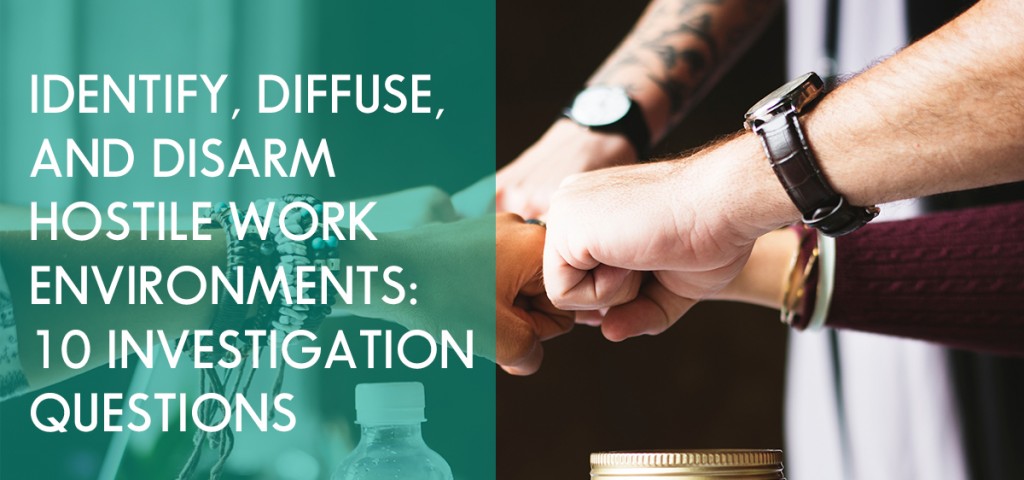
Managing safety in any workplace is important for keeping everyone, from workers to clients to supervisors, safe. Often times, workplaces can be hostile or unhealthy for employees due to a variety of reasons and the employer may not even be aware.
The first step is understanding what a hostile work situation is, then how to disarm it, and finally what steps to take to ensure it doesn’t happen again. If you are facing a hostile work environment and still have questions or concerns after reading this article please contact our consulting team here at Acute.
Contact the experts at ACUTE today to learn more about their consulting services and how they can help you and your workplace today. A safer working environment requires everyone to be on board.
Interested in ACUTE Consulting?

A Hostile Work Environment: What is it?
What constitutes a hostile work environment? Too many people, unfortunately, aren’t even aware that their work situations are toxic, hostile, and not as it should be.
Some employees believe that a bad boss, an unpleasant work environment, a rude coworker, failure to qualify for a promotion, or the lack of perks, privileges, benefits, and recognition can create a hostile work environment.
While these issues often contribute to a bad work environment, they do not mean that a work environment is hostile. There are certain legal requirements that must be met for a work environment to be considered hostile.
A hostile work environment is one where a colleague’s actions, communication, or behaviour makes doing your job difficult or impossible. The behaviour that creates a hostile environment must be discriminatory in nature.
In Ontario, this is regulated by the Ontario Human Rights Commission. With this understanding, we know that a coworker who is negative or talks loudly does not constitute a hostile work environment. However, a person who tells a sexually explicit joke is guilty of sexual harassment and creating a hostile work environment.
As well as discrimination and sexual harassment, it is important to understand that someone who verbally attacks your age, religion, gender, or race may be guilty of creating a hostile work environment. Even “casual” comments can turn hostile very easily, often without employees even being aware. Anything from a small office to a large corporation can have hostile work environments.

Legal Requirements for a Hostile Work Environment
- The actions and/or behaviour must discriminate a protected right such as age, religion, disability, or race.
- The behaviour must be repetitive and last over time. Short term “one-off” instances should be reported to your Human Resources committee, however, it is not considered a hostile work environment. The problem is hostile when it continues over time and is not addressed.
- The behaves must be severe. Not only should it continue over time, but it must seriously interrupt the employees work and/or career progress.
- It should be assumed that the employer was aware of the hostile actions or behaviour and did not intervene before a situation is legally hostile. As a result, the employer is liable.
![]()
5 Warning Signs of a Hostile Work Environment
- Discrimination – One major sign of a hostile work environment is one where colleagues discriminate against each other. Whether based on sex, age, race, religion, or even appearance. If you feel you are being discriminated it could be affecting your day-to-day work tasks or even limiting you from moving forward in your career.
- Sexual harassment – This is any form of inappropriate behaviour which has sexual connotations. This could be anything from innuendoes to someone talking to you or touching your body inappropriately. In our digital age, this can also mean an employee who emails, texts, or digitally sends inappropriate images or messages.
- Intimidation – Intimidation can be either physical or verbal. A boss can intimidate an employee with threats, or employees could be subject to physical intimidation from other employees. Facing intimidation affects your day-to-day work, your self-esteem, and even your health.
- Poor facilities – Failing to provide the right equipment can create a physically hostile environment. If there is poor lighting, lack of furniture, lack of ventilation, or poor sanitary facilities you may be in a hostile work environment. If you are forced to handle or work with dangerous materials without proper protective gear then you are working a dangerous, hostile environment.

Steps to Identifying why a Workplace is Hostile
A hostile work environment is a workplace where the worker fears going to work. Specifically:
1. The actions must discriminate against a protected classification.
2. The hostile behaviour or communication must be severe and pervasive.
3. The hostility must seriously disrupt the person’s work or interfere with her career development.
4. It is reasonable to believe the employer knew about the situation but did not intervene adequately.

A Real-Life Example: UBER
Uber has fired 20 employees over harassment, discrimination and inappropriate behaviour this past year. Uber publicly noted that there was an internal investigation into certain employees, and while they did not identify the employees who were fired they did identify that some were senior executives. A number of employees have said that the issues stem from cultural issues within the workplace.
“You only terminate 20 people after you’ve determined after an investigation that there is something very, very wrong at the company,” said Deborah Weinstein, the president of the Weinstein Firm, which deals with employment and workplace law issues. “Most places don’t have this level of things going wrong.”
Uber’s workplace troubles began in February when a female Uber engineer said in a blog post that she was sexually harassed by her supervisor and that the human resources department ignored the claims.
Read the full New York Times article here.

Hollywood
Hollywood is notorious for hostile work environments. Recently, The New Yorker published a story explaining the years of harassment and misconduct by Hollywood producer, Harvey Weinstein. Since then new allegations have been arising every day, of similar inappropriate behaviour from a number of public figures and executives. Sexual harassment policies in Hollywood and elsewhere need to be clear and unambiguous as to what is inappropriate in the workplace.
Read the full article here.
What are the Steps to Diffuse Hostility and Disarm Those who are Perpetrating Abusive or Hostile Acts
1. Listen patiently
Often times, listening properly is enough to neutralize an angry employee. Once the employee has finished sharing with you, repeat the main points back to them so that he or she is clear that you have listened to their complaints and understood the issue. Take time to interview them properly, listen, and ensure that they are heard.
2. Don’t be defensive
The more you deny or are offensive, the more wrong you seem. If someone attacks you or criticizes your assumptions, don’t start explaining yourself right away or denying your actions. Listen and ask questions to get the true story, ie: “how would you handle this?” Or “What do you think we should do?”
3. Don’t get angry
It is so easy to become frustrated or angry when something is personal, threatening, or discriminating. However, this is often counterintuitive to your end goal. The longer you stay calm the more in-control you are of the situation. Reacting destroys credibility.
4. Sidestep loaded questions
If an interviewee is feeling irritated or attached, they may ask a question with underlying accusations or assumptions. Many interviewers answer the question as asked, however it is better not to answer the question rather challenge the assumption behind the question. Ask “Can you explain what you mean by that question?” This ensures that they are exposed in what they are truly implying.
5. Know when to quit
There may be times an angry interview subject won’t calm down and is reactive. This is often out of control of the investigator and there could be a number of personal reasons for this reaction. There’s no point in wasting time, so know as an interviewer when to stop and reschedule.
![]()
14 Interview Questions for Workplace Investigations
Here are 10 questions to ensure you ask in a Workplace Investigation into a hostile work environment. Whether you are an internal Human Resources professional or an outside investigator, be sure to ask these questions:
- Where and when did the action take place? Is it ongoing?
- Who committed the alleged inappropriate behavior?
- What exactly happened? Who else was present? In regards to employee investigations — employee discrimination and workplace harassment cases can center on implied or perceived intent.
- How did you react?
- Did you ever indicate that you were offended or somehow displeased by the act or offensive treatment?
- Who else may have seen or heard the incident?
- Have you discussed the incident with anyone?
- Do you know of others who may have been affected by the actions? See if they will tell you who else may have been affected.
- Do you know whether anyone else reported the incident?
- How have you and your job been affected by the incident?
- Did you seek any medical treatment or counselling as a result of the incident?
- Are there any notes, physical evidence, or other documentation regarding the incident(s)?
- Is there anyone else who may have relevant information?
- What action do you want the company to take?
![]()
Stay Safe at Work With ACUTE!
Hands-on, practical consulting is the best way to keep employers and workers safe in the workplace! ACUTE is dedicated to workplace safety and understands the importance of disarming hostile situations. If you have questions about the legislation and how this will impact your workplace, get in touch with ACUTE today. Why get workplace safety training with ACUTE? Here are just some of the benefits of working with ACUTE.

- Open Door Instructor-Student Partnership – ACUTE’s training services emphasize client participation. Staff foster relationships with clients and serve as a touchstone for advice anytime moving forward.
- Serving Your Team and Industry – With a vast array of clients in manufacturing, construction, health, academic, and government sectors, ACUTE brings the best safety practices from across the spectrum to your workplace.
- 100 Years Combined Experience – ACUTE provides comprehensive health and safety training, on-site safety services, and consulting services. With over 100 years of combined experience, our company staff offer more than theoretical or abstract ideas. ACUTE offers solutions.
- Track Record of Success – ACUTE is rated 4.9/5 stars on Google reviews, demonstrating a commitment to our clients, quality, and passion for training.
“We have relied on ACUTE for years to train our staff and
keep them safe on the job site.”
– Bob, Millwrighting Company – Read More Testimonials Here!
Click here to see what training courses we have at ACUTE or contact us today for quality training in your workplace or on-site at ACUTE’s proven training facilities!
ACUTE is located in Waterloo, Ontario, and services customers from cities such as Toronto, Mississauga, Brampton, Hamilton, Milton, Kitchener, London, Guelph, and others across Ontario.


